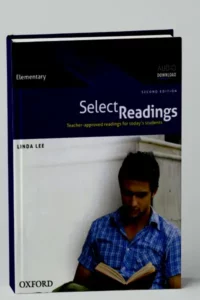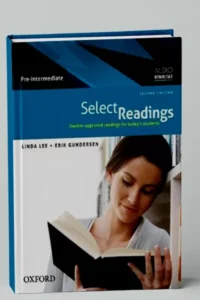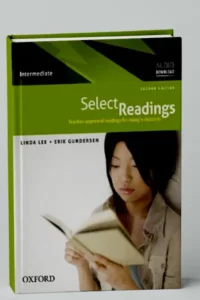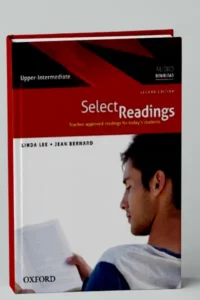Select Readings, Second Edition is a reading course for students of English. In Select Readings 2nd Edition, high-interest, authentic reading passages serve as springboards for reading skills development, vocabulary building, and thought-provoking discussions and writing.
The readings represent a wide range of genres (newspaper and magazine articles, personal essays, textbook chapters, book excerpts, and online discussions) gathered from well-respected sources, such as The Wall Street Journal, the Utne Reader, and Science News, and approved by experienced teachers.
Download Select Readings Second Edition Course pdf
Select Readings Second Edition Course: The 4-level course is designed to improve reading, comprehension and analysis of English texts by the Oxford publishing house. The course includes carefully selected, modern and relevant texts for the study of the English language that can be used as additional materials in the classroom or as a preparation for the exams, including TOEFL, TOEIC, IELTS, GEPT and others. Levels of difficulty from primary to high (Primary – High Intermediate)
General Approach to Reading Instruction
The following principles have guided the development of Select Readings, Second Edition:
- Exposing students to a variety of text types and genres helps them develop more effective reading skills. Students learn to handle the richness and depth of writing styles they will encounter as they read more widely in English.
- Readers become engaged with a selection when they are asked to respond personally to its theme. While comprehension questions help students see if they have understood the information in a reading, discussion questions ask students to consider the issues raised by the passage.
- Readers sharpen their reading, vocabulary-building, and language skills when skills work is tied directly to the content and language of each reading passage. This book introduces students to reading skills such as skimming and scanning and vocabulary-building strategies such as learning synonyms and understanding phrasal verbs. Each skill was chosen in consultation with teachers to ensure that the most applicable and appropriate skills were selected for students at the Intermediate level.
- Good readers make good writers. Reading helps students develop writing skills, while writing experience helps students become better readers.
- Background knowledge plays an important role in reading comprehension. An important goal of Select Readings, Second Edition is to illustrate how thinking in advance about the topic of a reading prepares readers to better comprehend and interact with a text.
Chapter Overview
Each chapter in Select Readings, Second Edition includes the eight sections described below.
1. Opening Page
The purpose of this page is to draw readers into the theme and content of the chapter with relevant artwork and a compelling quotation.
Teaching Suggestions:
- Ask students to describe what they see in the photo(s) or artwork on the page and guess what the chapter is about. Have them read the quotation, restate it in their own words, and then say if they agree with it. Finally, ask what connection there might be between the image and the quotation.
- Call students’ attention to the Chapter Focus box. Give them a chance to think about the content and skills they are about to study and to set their own learning goals for the chapter.
2. Before You Read
The first activity in each Before You Read section is designed to get students to connect personally to the topic of the chapter and to activate their background knowledge of the topic.
A second activity or question in this section asks students to further explore their knowledge of the topic by completing a task with a partner. The third activity asks students to complete a Previewing Chart, which provides specific tasks for previewing a text.
The purpose of this chart is to encourage students to make a habit of using simple previewing strategies before they read any text.
Teaching Suggestions:
- Make sure that students understand the purpose of the Before You Read activities. Explain that activating prior knowledge will help them to better comprehend the reading passage.
3. Reading Passage
In general, the readings become increasingly long and/or more complex as the chapters progress. To help students successfully tackle each passage, we have provided the following support tools:
- Vocabulary glosses. Challenging words and expressions are glossed throughout the readings. In most cases, we have glossed chunks of words instead of individual vocabulary items. This approach helps students develop a better sense of how important context is to understanding the meaning of new words.
- Culture and Language Notes. On pages 141-158, students will find explanations for cultural references and language usage that appear in blue type in the readings. Notes are provided on a wide range of topics from scientific information, to geographical references, to famous people.
- Maps. Each location featured in a reading passage is clearly marked on one of the maps found on pages 159-162.
- Numbered lines. For easy reference, every fifth line of each reading passage is numbered.
- Recorded reading passages. Listening to someone reading a text aloud helps language learners see how words are grouped in meaningful chunks, thus aiding comprehension.
Teaching Suggestions:
- Encourage students to read actively. Circling words, writing questions in the margins, and taking notes are three ways in which students can make reading a more active and meaningful experience.
- Play the recorded version of the reading passage and ask students to listen to how the reader groups words together. As they listen to the recording, students can lightly underline or circle the groups of words.
4. After You Read: Understanding the Text
Following each reading, there are two to three post-reading activities that give students the chance to (a) clarify their understanding of the text, (b) practice reading skills previously introduced, and (c) discuss the issues raised in the reading.
The first activity in this section is designed to give students practice with the types of comprehension questions used on exams such as TOEFL®, TOEIC®, and IELTSn1. Questions are also labeled to highlight the reading skill required to answer the· question.
Teaching Suggestions:
- Get students to discuss their reactions to the readings in pairs or groups. The process of discussing questions and answers gives students an opportunity to check their comprehension more critically.
- If time permits and you would like students to have additional writing practice, ask them to write a short essay or a journal entry on one of the questions in the Consider the Issues section.
5. Building Vocabulary
Reading extensively is an excellent way for students to increase their vocabulary base. Considering this, we pay careful attention to developing students’ vocabulary-building skills in each chapter of Select Readings, Second Edition.
A variety of vocabulary-building skills are introduced and recycled throughout the book. Each Building Vocabulary section starts out with a short explanation and examples of the skill in focus.
In the activities that follow the explanation, students typically scan the reading to gather and analyze various types of words and then use the words in a new context.
Teaching Suggestions:
- View the explanation and examples at the beginning of each Building Vocabulary section before asking students to tackle the activities that follow. Encourage them to ask any questions they have about the explanations or examples.
- Encourage students to keep a vocabulary notebook. Present various ways in which students can organize the words in their notebook: by chapter, by topic, by part of speech, etc.
6. Reading Skill
At the beginning of each Reading Skill section, students encounter a short explanation of the skill in focus and, when appropriate, an example of how that skill relates to the reading in the chapter.
The first task following this explanation asks students to return to the reading to think about and use the new reading skill.
The new Apply the Reading Skill sections then give students the opportunity to apply the strategy to a new short reading that is related to the topic of the main reading passage.
Teaching Suggestions:
- Review the explanations and sample sentences at the beginning of each Reading Skills section before asking students to tackle the questions that follow. Encourage them to ask any questions they have about the explanations or examples.
- Reflect with students on the ways in which they can apply the reading skills they have learned in each chapter to other reading passages. Then have them apply the new reading skill as they work with the second reading passage in this section.
7. Discussion and Writing
At the end of each chapter, students have an opportunity to talk and write about a variety of issues. The activities in this section provide students with a chance to broaden their views on the topic of the reading and to address more global issues and concerns.
Teaching Suggestions:
- When time permits, let students discuss a question a second time with a different partner or group. This allows them to apply what they learned in their first discussion of the question.
- Choose one or more of the questions in this section as an essay topic for students.
8. Words to Remember
Each chapter ends with a list of Words to Remember. All of these words appear on the Oxford 3000″‘ word list, and many are also highlighted on the Academic Word List.
This section provides an efficient means for students to keep track of important new vocabulary by chapter.
In addition, the new Mini-Dictionary on pages 163-172 features carefully crafted definitions of each Word to Remember from the new Oxford American Dictionary for learner, of English, giving students an alphabetical reference of the words and their definitions all in one place.
Elementary

Pre-Intermediate

Intermediate

Upper-Intermediate


